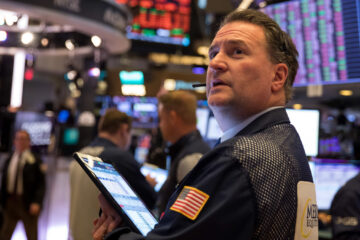The DJIA is one of the oldest and most popular American stock indexes.
kasto; Canva
What Is the Dow Jones Industrial Average (DJIA)?
When investors want to know how the stock market is doing, they turn to stock indexes like the Dow Jones Industrial Average (DJIA). Commonly known as “the Dow,” it is a collection of 30 blue-chip American companies that, when taken together, provide a snapshot of the overall stock market: When the Dow ends the trading day higher, investors take that to mean the overall market is up. When the Dow ends the day lower, the market is down.
The Dow is a price-weighted index, which means that each component company is weighted according to its share price. Higher-priced companies have a larger weight than lower-priced companies, and so their movement has a bigger impact on the index’s overall value. Stock splits, which happen when companies issue more shares to shareholders without diluting their value, have a particularly large impact on price-weighted indexes since the newly split stock has a lower price and thus is worth significantly less to the index.
The Dow differs from other indexes like the S&P 500 and the Russell 2000 in that it is price-weighted, while the other indexes are capitalization-weighted, which means each component is valued by its market cap, or the total value of all outstanding shares.
Why Is the DJIA Important?
The Dow is made up of 30 of the largest publicly traded companies in America, and it is one of the most well-known market indicators. Stock indexes like the Dow are important proxies for the New York Stock Exchange, and you’ll often hear it quoted on the nightly news. Stock indexes provide a quick picture of the total performance of the stock market on a daily basis—the DJIA is known as a benchmark index for U.S. blue-chip stocks, in particular.
Can I Buy the DJIA? What Is Its Ticker Symbol?
New investors may find the concept of the Dow a bit confusing: It is abbreviated as DJIA, but that’s not its ticker symbol. Its ticker symbol is DJI, but it’s not a stock, and you cannot buy or trade shares. While the Dow itself isn’t tradable, you can invest in the companies that make up the Dow; in addition, specific ETFs and mutual funds are designed to mirror the Dow’s composites. The reason the Dow’s ticker symbol is prominently displayed on Wall Street’s trading screens and financial data providers is so investors can see the market’s performance at a glance.
How Is the Dow Jones Industrial Average Calculated?
To calculate the Dow, you would simply add up the prices of its 30 stocks and divide the sum by the Dow Divisor, a numeral that factors in stock splits and stock dividends. The Dow Divisor is a universal way to understand the effect of a one-point move in any of the 30 stocks that make up the Dow.
The Dow Divisor changes frequently and is maintained by Dow Jones Indices. On January 10, 2022, the Dow Divisor was 0.152.
To calculate the Dow, add up its 30 stock prices and divide by the Dow Divisor.
chatchaiyo from Getty Images; Canva
How Are Stocks Selected for the Dow? Who Selects Them?
Interestingly, the Dow is selected by a committee of editors of The Wall Street Journal. They have the enormous responsibility of deciding which companies get added to (or dropped from) the Dow Jones Industrial Average. There are no rules for inclusion—just the general guidelines that a company’s market capitalization must be large, it must have an excellent reputation, and it must demonstrate sustained growth.
In fact, the only true requirements are that each company must be a non-transportation or non-utility company in the S&P 500.
“When selecting stocks for the Dow, we Journal editors simply try to reflect the market in just 30 stocks (minus transportations and utilities),” editor Mike Prestbo said in an article detailing some of the secrets of the Dow.
Which Companies and Sectors Are Currently in the Dow?
Here are the 30 companies that make up the Dow Jones Industrial Average along with their ticker symbols, the exchange they trade on, and the date they were added.
Dow Jones Industrial Average
The companies in the Dow represent a range of industries—everything from technology to industrial materials, financials, energy, consumer discretionary, and health care, to name a few. The 10 companies in the Dow with the largest dividend yields are typically referred to as the “Dogs of the Dow.”
And even though the Dow has a narrower focus than, say, the S&P 500, its long-term performance is actually very similar to broader indexes like the S&P 500.
Which Companies Have Been Dropped from the Dow?
Financial performance is a big factor in whether or not a company stays in the Dow, and it embraces market trends such as favoring technology and healthcare companies over, say, energy companies, although Chevron (CVX) is currently a part of the Dow.
Some of the biggest names recently dropped from the Dow include Bank of America (BAC), Alcoa (AA), HP (HPQ), Sears (SHLDQ), and General Electric (GE).
What Other Stock Indexes Are Out There?
Stock indexes can represent the entire market or a particular industry or segment. They are used by investors, fund managers, and analysts to understand a particular industry or the broader market—as well as gauge its performance. They can be price-weighted or capitalization-weighted.
In addition to the Dow, five popular US indexes include:
S&P 500NASDAQ CompositeWilshire 5,000Russell 3000NYSE Composite
What Are Some Criticisms About the Dow?
Because there are only 30 companies in the Dow, critics think it is an inadequate representation of the stock market at large. The fact that it ignores market cap is another reason many analysts favor the S&P 500 over the Dow as a stock market benchmark. TheStreet’s Eric Jhonsa believes the August 2020 addition of Salesforce (CRM) to the Dow illustrates how arbitrary the index’s mechanics can be.
What Is the History of the Dow Jones Industrial Average?
The Dow is one of the oldest stock market indexes, created in 1896 by Charles Dow, founder of The Wall Street Journal. The Dow was named partly in his honor; Jones comes from the newspaper’s co-founder, Edward Jones, who was also a statistician. The original Dow index only contained 12 stocks and truly was average weighted—to find out its average, all you would need to do was add up the share prices of the 12 companies and divide by 12.
Today, the index is maintained by S&P Dow Jones Indices.


